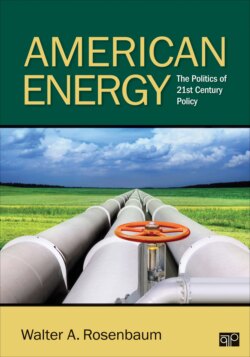American Energy

Реклама. ООО «ЛитРес», ИНН: 7719571260.
Оглавление
Walter A. Rosenbaum. American Energy
American Energy
Contents
Box
Table
Figures
Preface
Chapter 1 The Politics of Policy
The “Well From Hell”
”I Had No Idea It Could Do What It Did”
A Massive Impact
Federalism With Raw Edges
”A Different Disaster”: The Media Sends a Message
The Challenge of Policy Reform
”Only the First Step”
Making Energy Policy: A Primer
The Constitution
Incrementalism, “Punctuated Equilibrium,” and Lurches
Governing Energy: Federal Institutions
Governing Energy: The States
Policy Drivers
Public Opinion
The Economy
Crisis
Political Partisanship
Environmentalism
Interest Groups
The Tyranny of the Electoral Cycle
Globalization
Reserves and Resources: How Much Energy?
National Security
What Follows: American Energy in Transformation
Chapter 2 Managing Energy: A Policy Primer
From Abundance to Insecurity
Fossil Fuel Nation
The Energy Boom Arrives and Departs: 1945–1988
From Insecurity to Renewed Planning: 1988–2008
Imagining the “Clean Energy Superhighway”: The Obama Administration
Governing and Choice: Energy Policy Options
Governance and Regulation
Energy Taxes
Subsidies
Research and Development (R&D)
Rationing
Price Controls, Quotas, and Tariffs
National Energy Planning
Conclusion: the Governed Energy Marketplace
Chapter 3 Carbon Policy: Petroleum and Natural Gas
An Era of Transformation
Petroleum
Growing Exports, Decreasing Imports
Risks As Well As Rewards
The Politics
Governing Petroleum: Seeking a Policy Future
Federal Subsidies and Related Petroleum Production Incentives
Accelerated Domestic Exploration and Production
Creating More by Using Less: Petroleum Conservation and Substitution
Ethanol
Natural Gas: A Mix of Rewards and Risks
Domestic Resources: Increasing Supply and Demand
A Versatile Fuel
”Almost a Miracle” or an Environmental Menace?
Governance: Future Policy Options
Conclusion: The Foundation of Energy Policy
Chapter 4 Carbon Policy: Coal
The Troubled Future of Future Gen
The Resource: “A Saudi Arabia of Coal”
Once America’s “Great Black Hope”
A Troubled Future
When “Clean Coal” Isn’t Clean: The Environmental Impact of Coal
The Politics of Coal Policy
The Coal Industry
Electric Power and Coal
The United Mine Workers
Environmentalism and Coal
Governance: Coal Policy and the Future
Obama, Coal, and a “New Energy Future”
Surface Mining and Mountaintop Removal
Coal and Clean Water: Coal Ash
The Uncertain Search for “Clean Coal”
Coal, Climate Warming, Deadlock, and Improvisation
The Clean Air Act and CO2
Cap and Trade
Meanwhile, the States Take the Initiative
Conclusion: Coal at the Crossroads
Chapter 5 Nuclear Energy
A Rising and Fading “Renaissance”
Visions of Revival
A Blighted Vision
The Commercial Nuclear Power Industry Today
A Turn of Fortune
The Federal Patron
The Problematic Economics of Nuclear Power
Facility Safety Issues
The Waste Nobody Wants
The Nuclear Regulatory Commission
Governance: Confronting The “Nuclear Option”
Closing Out the Nuclear Option
Sustaining the Nuclear Option
Solving the Waste Problem
Conclusion
Chapter 6 Renewable Energy and Electric Power
A Path Not Yet a Highway
Renewable Energy: the Resource
A Varied and Abundant Resource
Solar Power
Wind
Biomass
Governance: the Policy Challenge of Renewables
The Importance and Growth of Federal Incentives
A Variety of Policy Options
The Resilient States
The Obama Administration’s “Green Agenda”
Policy Constraints
Electric Power
The Resource: Electric Power and Renewable Energy
Governance: Regulatory Federalism
Federal Regulation
State Regulation
Promoting Competition and Markets
The “Smart Grid”
State and Local Government Initiatives: RPS and FITs
Conclusion
Chapter 7 American and Global Energy
Rising Global Energy Demand
Surging Energy Consumption
The Policy Challenges
Global Climate Change
The US and Global Climate Change
Box 7-1Global Climate Change Impacts in the United States: Key Findings
The Policy Challenges
Improving Energy Security
The Policy Challenges
“Riding the Wave” of Technology Innovation
The Policy Challenges
Conclusion: the Global Imperative
Endnotes
Index
About the Author
Отрывок из книги
The Politics of 21st Century Policy
i Clifford Krauss and Tom Zeller, Jr., “When a Rig Moves In Next Door,” New York Times, November 7, 2010, BU:1.
.....
The Department of Energy (DOE). Created in 1977 as a cabinet department, DOE’s responsibilities now sprawl across the entire range of energy-related federal government activities.23 In 2013, the DOE had a budget of $27.2 billion and about 16,000 employees. Currently, the DOE implements policies involving nuclear power, fossil fuels, and alternative energy resources, and it assumes responsibility for advancing the national, economic, and energy security of the United States, for supervising the national laboratories initially created for the development of nuclear weapons, and implementing the White House’s National Energy Policy Development Group. DOE also inherited a double dose of hugely expensive and contentious nuclear regulatory responsibility: the agency administers the enormously costly, technically difficult, and politically volatile environmental cleanup of the nation’s former nuclear weapons facilities and also assumes responsibility for the safe disposal of nuclear waste from the nation’s commercial and military weapons facilities.24
From its inception, the DOE has had too much to do, too few friends, and too little authority. Much of the authority for domestic energy planning remains with the Nuclear Regulatory Commission, the EPA, the Department of Agriculture, and other agencies beyond DOE’s statutory reach or political influence.
.....